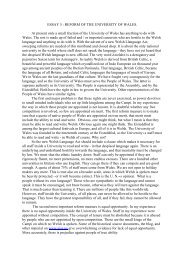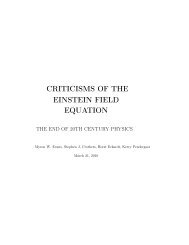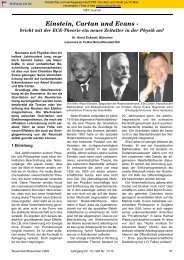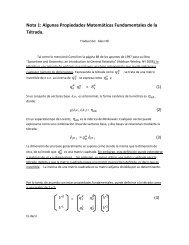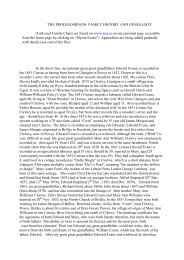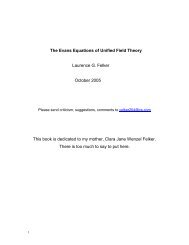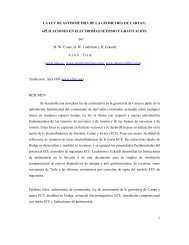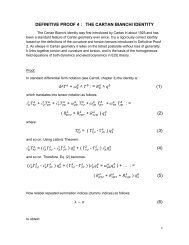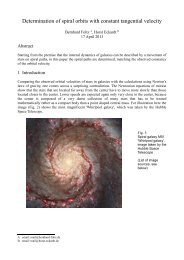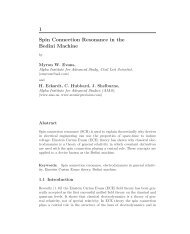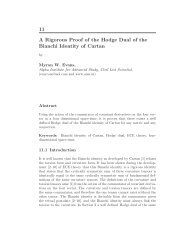Einstein, Cartan and Evans – Start of a New Age in Physics?
Einstein, Cartan and Evans – Start of a New Age in Physics?
Einstein, Cartan and Evans – Start of a New Age in Physics?
Create successful ePaper yourself
Turn your PDF publications into a flip-book with our unique Google optimized e-Paper software.
ECE Theory, H. Eckardt, L. Felker 09. Dec. 2005<br />
Introduction<br />
For centuries, physicists <strong>and</strong> philosophers sought a unified description <strong>of</strong> all phenomena <strong>of</strong><br />
Nature. We know today that the world at the sub-microscopic quantum scale behaves very<br />
differently than our familiar macroscopic experience. In particular, theories <strong>of</strong> gravitation<br />
have been irreconcilable with quantum theory. Therefore, one expects that, if gravitation<br />
could be unified with quantum theory, wholly new <strong>in</strong>sights would result. It now appears that<br />
this unification has been achieved, but not <strong>in</strong> the manner expected by previous generations<br />
<strong>of</strong> scientists. This unification predicts fundamental new effects <strong>–</strong> for example, the production<br />
<strong>of</strong> energy (or power) without need for <strong>in</strong>put <strong>of</strong> other primary energy. This prediction, among<br />
others, is creat<strong>in</strong>g great <strong>in</strong>terest <strong>in</strong> pr<strong>of</strong>essional <strong>and</strong> scientific circles. We now review the<br />
orig<strong>in</strong>s <strong>of</strong> this unification.<br />
Albert <strong>E<strong>in</strong>ste<strong>in</strong></strong> <strong>in</strong> 1915 published a theory <strong>of</strong> the gravitational <strong>in</strong>teraction; he called this the<br />
theory <strong>of</strong> General Relativity, <strong>and</strong> today it provides the basis for our underst<strong>and</strong><strong>in</strong>g <strong>and</strong><br />
exploration <strong>of</strong> the cosmos at large. In 1905, <strong>E<strong>in</strong>ste<strong>in</strong></strong> had already produced the theory <strong>of</strong><br />
Special Relativity, which rests upon the well-known postulate <strong>of</strong> “constancy <strong>of</strong> the speed <strong>of</strong><br />
light“ <strong>in</strong> vacuum. Dur<strong>in</strong>g the last thirty years <strong>of</strong> his life, <strong>E<strong>in</strong>ste<strong>in</strong></strong> looked for a still more<br />
comprehensive unified theory which could cover all known natural forces. He spent the years<br />
from approximately 1925 to 1955 <strong>in</strong> this search, but did not reach his desired goal. S<strong>in</strong>ce the<br />
discovery <strong>of</strong> quantum mechanics <strong>in</strong> the 1920’s, the majority <strong>of</strong> physicists busied themselves<br />
with this, <strong>and</strong> not with General Relativity. The fact that quantum mechanics is consistent<br />
only with Special Relativity, but not with General Relativity, was overlooked or ignored. In<br />
addition, while quantum mechanics is successful <strong>in</strong> describ<strong>in</strong>g the electron sheath <strong>of</strong> atoms;<br />
it is not a suitable theory for the high mass-densities which occur with<strong>in</strong> atomic nuclei.<br />
Other notable progress toward unified theory <strong>in</strong> the 20th century consisted <strong>of</strong> a unification <strong>of</strong><br />
electromagnetism with the weak nuclear force, via an extension <strong>of</strong> the formalism <strong>of</strong> quantummechanics.<br />
Gravitation has rema<strong>in</strong>ed, until today, outside the St<strong>and</strong>ard Model <strong>of</strong> particle<br />
physics.<br />
Elie <strong>Cartan</strong> is less well-known than <strong>E<strong>in</strong>ste<strong>in</strong></strong>. He was a French mathematician who<br />
exchanged ideas with <strong>E<strong>in</strong>ste<strong>in</strong></strong> concern<strong>in</strong>g many details <strong>of</strong> General Relativity. <strong>Cartan</strong>’s<br />
orig<strong>in</strong>al <strong>in</strong>sight was that electromagnetism could be derived, via differential geometry, from<br />
the geometry <strong>of</strong> space-time <strong>–</strong> more or less <strong>in</strong> parallel with <strong>E<strong>in</strong>ste<strong>in</strong></strong>’s <strong>in</strong>sight that gravitation<br />
could be derived from space-time geometry.<br />
A successful unification, however, was not achieved by <strong>Cartan</strong> <strong>and</strong>/or <strong>E<strong>in</strong>ste<strong>in</strong></strong>. The<br />
unification was f<strong>in</strong>ally achieved <strong>in</strong> the year 2003 by Myron <strong>Evans</strong> who, tra<strong>in</strong>ed as a chemical<br />
physicist, brought fresh <strong>in</strong>sight to the problem. <strong>Evans</strong> held several academic pr<strong>of</strong>essorships<br />
<strong>in</strong> Engl<strong>and</strong> <strong>and</strong> the USA, before he was forced to withdraw because <strong>of</strong> his unorthodox views,<br />
<strong>and</strong> he now works as a “private researcher“ <strong>in</strong> his homel<strong>and</strong> <strong>of</strong> Wales. From there, he<br />
conducts the “Alpha Institute for Advanced Study“ (AIAS), which presents his ideas to the<br />
public as a world-wide team or work<strong>in</strong>g-group. A popular-scientific presentation is <strong>in</strong> [3].<br />
Recently concentrat<strong>in</strong>g its work on energy production from the vacuum -- a topic which<br />
established science avoids <strong>–</strong> the AIAS website generates large <strong>in</strong>terest, as shown by the<br />
steady <strong>in</strong>crease <strong>in</strong> web-page statistics on the AIAS site [4]. Many well-known universities <strong>and</strong><br />
research establishments world-wide have visited these pages.<br />
1 The four natural forces<br />
To underst<strong>and</strong> the importance <strong>of</strong> unification, one must start with knowledge <strong>of</strong> the quantities<br />
be<strong>in</strong>g unified. It is widely accepted <strong>in</strong> physics that all <strong>in</strong>teractions <strong>in</strong> Nature are<br />
manifestations <strong>of</strong> four fundamental forces. . We characterize these briefly as follows:<br />
1. The seem<strong>in</strong>gly separate force-fields generated by electrostatic charge <strong>and</strong><br />
magnetism were united <strong>in</strong> the 19th century, largely by Maxwell, <strong>in</strong>to what is now<br />
called electromagnetism, or the electromagnetic field.



